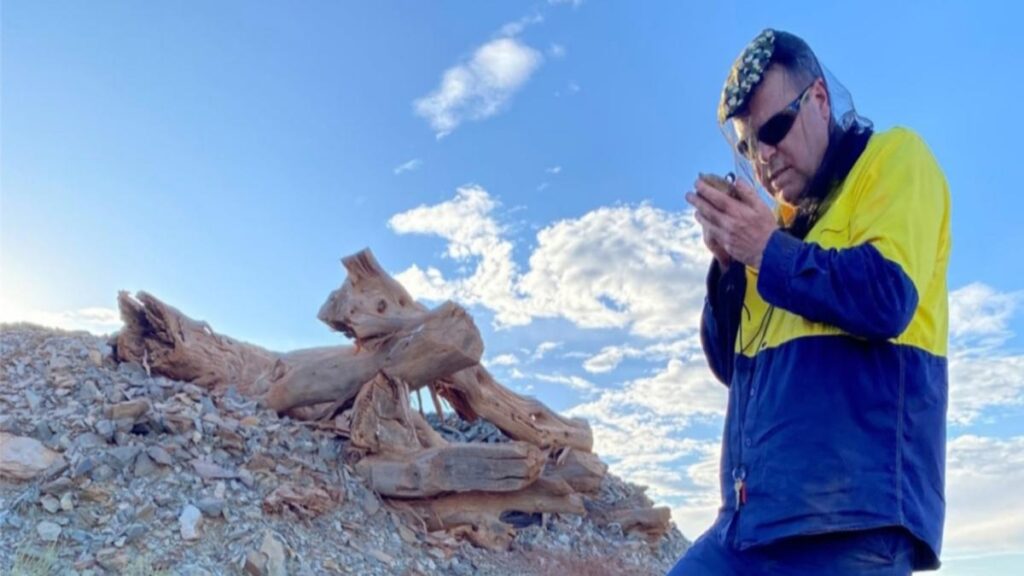Great Southern Mining has assayed 3 metres at 2.55 grams per tonne (g/t) gold from 33m, including 1m at 6.48g/t gold, in the final results from the company’s February reverse circulation drilling program at its Golden Boulder East trend, within its Duketon project in Western Australia.
The hole included a separate intercept of 2m at 1.81g/t gold from 42m. A second hole probed 1m assaying 1.02g/t gold from 53m and 2m at 1.42g/t gold from 60m.
Three other holes drilled on the company’s Golden Boulder Main trend delivered 2m at 2.10g/t gold from 18m, 1m at 1.16g/t gold from 69m and 1m at 1.70g/t gold from 81m, and 2m at 1.60g/t gold from 24m, respectively.
In late March, the company reported two emphatic hits from Golden Boulder, with one hole intercepting 4m at 2.03g/t gold from 24m, including 2m at 3.5g/t gold, while a separate 5m intercept in the same hole delivered 14.57g/t gold from 41m, including 1m at a sizzling 70.94g/t.
A second previously reported hole bored out 1m at 2.20g/t gold from 61m, 1m at 1.05 g/t gold from 88m and 2m at 12.56g/t gold from 99m, including 1m at a respectable 18.21g/t gold.
Last month’s two high-grade results and Great Southern’s latest 1m at 6.48g/t result confirm that good grades can be found in the system.
These appear to occur within envelopes carrying lower but still significant grades. Great Southern may see this as particularly encouraging considering the current gold climate, where the yellow metal is running at $5282 per ounce, which translates to a once unbelievable $169 per gram gold.
Golden Boulder includes three parallel trends, the Main line, Eastern line and Ogilvies, which form part of a distinct north-south structural corridor offering abundant evidence of gold mineralisation in multiple nearby and often significant deposits.
These include Regis’ more than 2-million-ounce Rosemont deposit, 380,000-ounce Baneygo show and the 390,000 ounces of gold that comprise its Ben Hur deposit.
Apart from those more notable operations, more than 50 historical workings have been identified within a 3-kilometre strike trend of Golden Boulder and its adjacent related zones.
Mines department records refer to historical production for the area between 1900 and 1955 of 1915 tonnes, averaging 28.6g/t gold for 1761 ounces of gold.
Serendipitously, the Golden Boulder Main line of mineralisation is concentrated in quartz veins within steeply dipping, stacked shears hosted in doleritic geology, meaning that gold occurrences are relatively predictable, enabling the company to nail intercepts within 10m of the depths predicted in modelling.
The company says the Eastern trend – about 1km north of and 300m east of the Main trend – follows a sheared sequence of sedimentary and ultramafic strata, which is intruded by a sheared dolerite and a felsic porphyry. Mineralisation occurs near the intruded contacts.
This latest round of drilling at the Golden Boulder prospect has highlighted continuity of mineralisation and a propensity for shallow, high grade gold intercepts. Mineralisation has been defined over a strike length of 1.5 kilometres and, importantly, the recently completed heritage survey will enable our team to drill test additional targets for a further 2 kilometres to the south.
In other work, the company’s first drilling program at its Boundary prospect has also met with success. Boundary is about 4km southeast of Golden Boulder and on the main trend that includes Regis’ Ben Hur and Garden Well operations.
Four of seven holes at the prospect have thrown up grades of better than 1g/t gold, including the company’s most recent intercept of 2m at 1.31g/t gold from 112m, including 1m at 2.06g/t gold.
Great Southern has also put in a small first program of scout drilling at its Ogilvie North prospect, involving five holes arrayed along a 600m strike.
The program is testing a 1km-long surface gold anomaly, which coincides with a magnetic low in the northern part of the Ogilvie line of strike within Great Southern’s ground.
While the source of the surface anomalism remains to be resolved, the best response to the program was 2m at 0.66g/t gold from 122m, associated with hematite alteration.
Great Southern is now engaged in modelling and interpretation to prepare for more drill testing planned for the company’s Southern Star, Golden Boulder and Amy Clarke prospects, all focused on resource definition.
Great Southern’s Duketon project embraces more than 400 square kilometres of ground in a demonstrably well-endowed gold belt. The company has defined multiple targets along the three main structural trends that host most of the gold deposits in the Duketon greenstone belt, many of which have yet to be tested.
The company has sought and has been granted heritage clearance for the prospective corridor that extends south of the mineralised trends at Golden Boulder, which will permit further exploration – including a drilling program – for an additional two kilometres southward along strike.
Is your ASX-listed company doing something interesting? Contact: matt.birney@wanews.com.au
https://thewest.com.au/business/public-companies/great-southern-scores-more-high-grade-hits-in-latest-wa-drill-program-c-18475172


